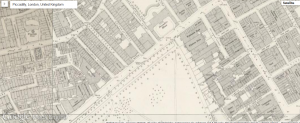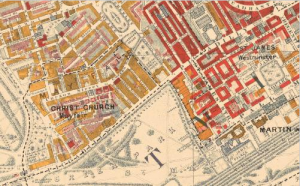
The Charles Booth Poverty Map reveals that Piccadilly was largely populated by the upper and middle classes with “fairly comfortable” in some areas. On The Proceedings of Old Bailey the results for crimes committed on Piccadilly show that the majority of them were variations of theft ranging from burglary to shoplifting and only a few of the crimes were considered violent. The high amount of theft seems logical considering it was a richer area with plenty of shops. There would have been quite a few places to target. 
According to British History Online, “Piccadilly has for centuries been one of the two most important highways leading to the metropolis from the west” (BHO). Clearly, this street has always been well-traveled and essential to getting around the city. There were several well known places on this street such as Burlington House, Burlington Arcade—described as “a long, covered avenue lined with small, but beautiful shops”—, the Royal Academy, and the Egyptian Hall (Historical Eye). In The Picture of Dorian Gray, this street is mentioned by Dorian Gray when he is explaining to Lord Henry how he had reacted to Henry’s words which had “filled [him] with a wild desire to know everything about life” (Chapter 4). To quell this wild desire, Dorian explains that he strolls down Piccadilly and watches people: “As I lounged in the park, or strolled down Piccadilly, I used to look at every one who passed me and wonder, with a mad curiosity, what sort of lives they led” (Chapter 4). Piccadilly would be a good place to watch a variety of people, especially considering the attractions located along the street; the shops and other popular places drew in all sorts of people. Dorian’s adventures on Piccadilly—a relatively safe street, at least in terms of violence—eventually lead to his exploration of the “grimy streets” of London—presumably a more dangerous, lower class area—where he discovers Sibyl Vane (Chapter 4).
